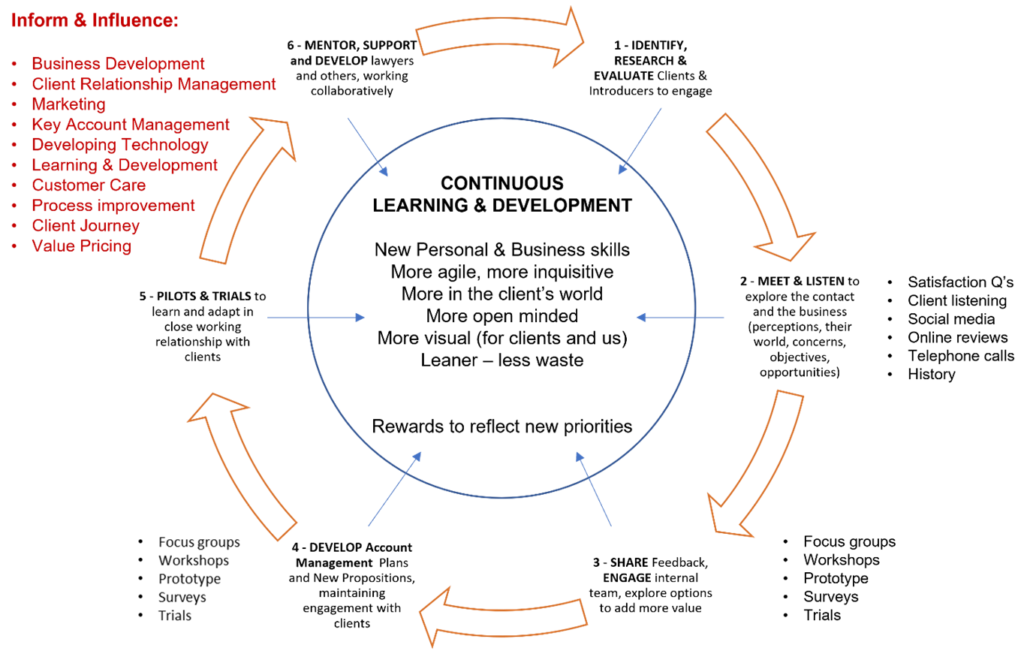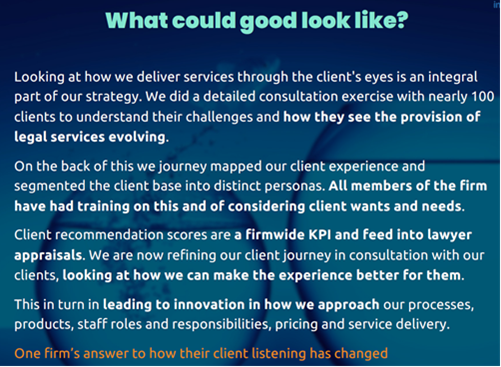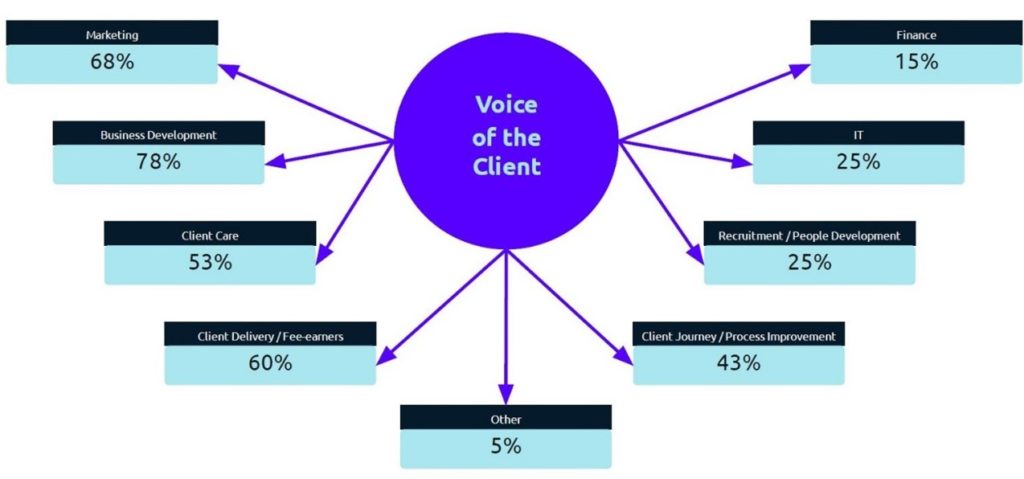
The voice of your clients – and others you deal with – has potential to play much more of a leading role in the ongoing development and evolution of law firms.
How to harness the voice of the client
An “agile” business – as more and more firms recognise the benefits of being one – must have a deep understanding of clients at the centre of everything. The first step is to establish regular and consistent client feedback mechanisms, such as surveys, focus groups, workshops and pilots to trial and test new and better ways of doing things. But then what? People very easily run out of time and leave this job unfinished.
By using insight from clients to inform and influence both strategic and operational decisions across a wider spectrum on business development, marketing, HR and technology, a firm can learn quickly and tailor their services accordingly – always aiming to deliver more of what clients (and prospects) want.
The generic model below is a good starting point to show how the voice of the client can feed different aspects of development in the practice – to be customised and further refined, perhaps to incorporate more of the Agile approach more law firms are aspiring to. How the client feedback can be harnessed strategically to best effect, to play what should be a leading role in the ongoing, continuing development and evolution of a law firm fully equipped to make the most of opportunities.
You have perhaps already begun to move in that direction – as more firms are now, to keep developing going forwards in team meetings, workshops, focus groups … working with pilots in key areas in time.

All of this feeds into the continuous learning and development, performance measures and rewards for people over time.
To make this happen, experience confirms that a law firm needs a focused driver to establish and maintain the interconnected initiatives involved and to keep momentum going on disparate projects and initiatives covering most areas of the business. Also, to get heard at Management Board level to inform and influence both strategic and operational decisions.
So, the now-critical responsibility for leading initiatives around the “Voice of the Client” should potentially rest with a “Chief Client Strategy Officer” (CCSO) or similar director level role. Their job is to serve alongside the C-suite executive board (CEO, CFO, CIO, COO, CMO) to solve lasting client/customer problems, identify and develop opportunities, build a long-term competitive advantage, retain loyal customers, and create a strategy to help increase profit from customers – always working alongside, supporting and informing Business Development, Marketing, Operations, People Development, Technology and Innovation.
Although there needs to be a person or team with responsibility to lead and drive these initiatives, it is essential that everyone comes to recognise that hearing and responding to that voice should always be part of their responsibility. Reaching that stage is one level of success that will take time and a carefully developed plan with vision to carry through some version of the initiatives outlined here.
Why?
Reflecting “Agile” thinking, the Voice of the client should be at the centre to lead initiatives on every front, from the legal service, communication, pricing, use of technology … to training and development pathways needed to build the right skillsets. If clients see value in soft skills, more apparent emotional intelligence and commercial initiative to improve their experience, lawyers and others should be rewarded for using them successfully. If clients are looking (or not looking) for improvements in these areas and others, we need to know what and why – to act on it collectively.
Talking now about “innovation” might well be dangerous for firms that have yet to develop more confidence and assurance that they can deliver it right. If that’s the case, there is a need to get more tangible client feedback-led initiatives up, running, tried and tested to confirm and prioritise. Deep listening is the best way to make decisions about what different (marginal or radical) would add more value and is worth doing – and relative priorities. Get that established to give the confidence and assurance to start to talk about innovation more overtly.
How?
Ideally, your practice would adopt automated “always on” client listening, using something like the solution from MyCustomerLens to let you capture and evaluate more feedback from more channels and free up time to think, talk and do. A growing number of firms within the top 100 – including well below the top 20 – are at relatively early stages of using this kind of tool, capitalising already on AI to automate the aggregation, evaluation and distribution of client feedback 24/7. Aiming to do that and respond before feedback goes stale. However, this is just a tool. Successful results still depend on how you use that knowledge, but automated “always-on” listening, evaluation and distribution is a new option that makes much more possible.
Also using simple project management tools like Microsoft 365 Planner and Project (which now incorporates Agile Kanban and Scrum tools) to support effective collaboration on projects. You may already use it? There would be benefits in introducing lawyers as well as managers to the concept of agile project management over time too. I tend to use Miro or Cemantica for customer journey maps and interactive sessions but again you already may use other similar tools.
You want to get the right balance and mix of skills in your practice to do this effectively and get the focus right, with good resources, mindsets and a relatively flat structure to work with – and a good office environment.
Where are we now, how far and how fast should we move?
We carried out benchmark surveys in 2021, ’22 and ’23 (with the ’23 results being shared with participating firms now), asking law firms and other professional practices how, when and how often they capture and use the voice of the client. The summary below is a good overview of how one described their recent activity at that stage over a year ago, but most firms probably haven’t taken it this far … yet?
This can’t happen overnight, so see it as a 3-to-5-year project, with stages to be managed, re-evaluated and adapted over the period. Change is inevitable and must be constantly catered for as everything in the client’s world (not just ours) keeps moving on.

What next?
Can the Voice of the Client make more of a positive impact on development of your practice?
Our 2023 research confirms again that firms are only gradually moving towards use of client feedback to inform strategy and initiatives in areas outside Business Development such as IT/Technology, Financial Management and People Development, which present a lot of opportunity for the future.
There is increasing potential for a new CCSO role in law firms – bringing together Business Development, Technology, Innovation and Agile (project management) touching all the areas discussed above. Their objectives should be to grow the customer base, enhance profitability, increase the strength of the customer base as an asset, balance the management board’s traditional focus on cost cutting and revenue-growth.
The chart below from our research confirms that feedback from clients is rarely shared (only 25% of firms do) to inform initiatives on development of technology. An essential area where client needs and wants should be better understood to build and deploy technology that fits with their operations and their world.
Q – Which areas of your firm use client listening to inform their activities and decision making?

In summary
A separate, respected Voice of the Client role across the business would emphasise the importance of incorporating it in ALL areas because:
1. An “agile” business must have a deep understanding of clients at the centre of everything.
2. You want to capture, share and embed a clear picture of different client values/expectations, their world, their objectives and challenges. Also, their perceptions of service today for immediate action and fixes before their transaction comes to an end if it can help – as well as long term development. About the individuals running client businesses as well as the business itself and introducers, particularly where we have a business partner relationship.
3. It ensures a client perspective on everything. Use different profiles / personas to test against but kept under constant review and development as everyone continues to learn more, options and needs change.
4. Piecemeal feedback is not enough – ideally, aggregate qualitative and quantitative information from multiple sources that probably include …
- Routine satisfaction survey
- Social media
- Solicitor review sites
- Client / Matter reviews and deeper listening
- Telephone calls
- Conversions – successful and not
- … and more.
5. You can make the most of “always-on” listening – 24/7 feedback, constantly topped up, evaluated, shared and discussed internally and with clients – not one-off exercises.
6. You can then review and build profiles of clients and sectors of interest and of options to refine existing – and develop new – service propositions, being prepared to be radical at least some of the time.
7. You can take advantage of opportunities to explore evaluation of feedback (presented visually) at internal meetings as an integral part of team discussions – agreeing over time what is best for each of the teams. Let them define and develop as they learn and their understanding grows.
8. The practice can begin to identify agile and “O-shaped” skills needed going forwards to equip teams to work together and deliver – based on client and business partner feedback. Need to ask questions of clients and of ourselves. Collaborate with and align HR and performance reviews.
9. The “Outside-In” approach enables your people to map, evaluate and adapt at least some of the client journeys, to understand the impacts, opportunities and gaps.
10. Defined “agile” initiatives to use this ammunition to understand and continuously improve:
- Client & Matter onboarding.
- Communications.
- Pricing and billing.
- Upselling other services.
- Associated products and services.
- Services where we win business by tendering.
- Other processes over time that come to the top as priorities.
11. There is a path here towards more visualisation of measures and performance data that can be more easily digested – both internally by lawyers and the management team and externally in the course of legal work and using management data to inform everyone.
12. You can engage your people across disciplines (legal and management) with clients to develop, pilot, evaluate and learn, modify and deliver better service propositions that deliver better perceived value for clients and prospects you want to retain and attract.
13. You will create more opportunities to mentor your people (as per the model) and continue to fill gaps in skills and on delivering effective client and business partner (account) management.
The results will be:
- Increased revenue and/or profit per client – keep developing metrics and visualisation.
- Improved wins and conversions – because offering better matches needs.
- Higher client satisfaction levels.
- More client relationship time.
- Improved processes, reduced emails etc.
- A better personal development plan for lawyers and across the practice.
- Improved and better shared management information across the business.
- Better aligned recognition and rewards.
- … or other/more alternatives agreed by the Management and Executive teams … and the lawyers.
Next steps
For further information about any of the tools and approaches mentioned here, or to discuss how you can best develop your current client feedback and listening programmes, contact Allan Carton. Email acarton@cartonconsultants.com. Telephone 07779 653105. Connect on LinkedIn.
Photo by rawpixel.com form PxHere.